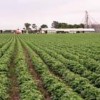 El objetivo de esta publicación EDIS es poner en evidencia los descubrimientos recientes que se enfocan en la ecología de los patógenos humanos en el área de producción de cultivo. Una mejor comprensión de cómo los patógenos persisten fuera de los huéspedes animales en el agua para la agricultura, en el suelo y en las plantas, tendrá grandes impactos en el manejo y procesamiento de los productos mismos, empezando desde el productor y hasta el consumidor. This 3-page fact sheet was written by Massimiliano Marvasi, Max Teplitski, Andrée George, and George Hochmuth, and published by the UF Department of Soil and Water Science, November 2012.
El objetivo de esta publicación EDIS es poner en evidencia los descubrimientos recientes que se enfocan en la ecología de los patógenos humanos en el área de producción de cultivo. Una mejor comprensión de cómo los patógenos persisten fuera de los huéspedes animales en el agua para la agricultura, en el suelo y en las plantas, tendrá grandes impactos en el manejo y procesamiento de los productos mismos, empezando desde el productor y hasta el consumidor. This 3-page fact sheet was written by Massimiliano Marvasi, Max Teplitski, Andrée George, and George Hochmuth, and published by the UF Department of Soil and Water Science, November 2012.
http://edis.ifas.ufl.edu/ss577
Tag: Andree George
Salmonella and Pathogenic E. coli in the Crop Production Environment: Potential Sources, Survival, and Management (SL375/SS576)
 Over the last two decades, at least a dozen major outbreaks of gastroenteritis caused by non-typhoidal Salmonella or enterovirulent E. coli have been linked to the consumption of sprouts, nuts, and fresh (or minimally processed) fruits and vegetables. These outbreaks caught scientists and the public off guard because these pathogens were not previously considered “plant-associated.” This 3-page fact sheet highlights recent discoveries that focus on the ecology of human pathogens in the crop production environment. A better understanding of how pathogens persist outside of animal hosts in agricultural water, soils, and plants will have major impacts on managing produce safety from “farm to fork.” Written by Max Teplitski, Andree George, and George Hochmuth, and published by the UF Department of Soil and Water Science, October 2012.
Over the last two decades, at least a dozen major outbreaks of gastroenteritis caused by non-typhoidal Salmonella or enterovirulent E. coli have been linked to the consumption of sprouts, nuts, and fresh (or minimally processed) fruits and vegetables. These outbreaks caught scientists and the public off guard because these pathogens were not previously considered “plant-associated.” This 3-page fact sheet highlights recent discoveries that focus on the ecology of human pathogens in the crop production environment. A better understanding of how pathogens persist outside of animal hosts in agricultural water, soils, and plants will have major impacts on managing produce safety from “farm to fork.” Written by Max Teplitski, Andree George, and George Hochmuth, and published by the UF Department of Soil and Water Science, October 2012.
http://edis.ifas.ufl.edu/ss576